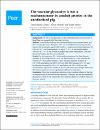The vascular glycocalyx is not a mechanosensor in conduit arteries in the anesthetized pig.
Abstract
The role of the glycocalyx as the endothelial sensor of an increase in blood flow was assessed in the iliac artery in vivo. Acetylcholine-induced flow mediated dilation was evaluated before and after vascular glycocalyx disruption. This was accomplished by exposing the iliac lumen to the chemotactic agent fMLP (1 μM; = 6 pigs), concomitant heparinase III (100 mU ml) and hyaluronidase (14 mg ml) ( = 4), and neuraminidase (140 mU ml; = 5), for 20 min in separate iliac artery preparations. Only one lumen intervention per iliac was conducted. For the heparinase III + hyaluronidase experiment, the iliac diameter increased by an average of 0.54 ± 0.11 mm before and 0.45 ± 0.03 mm after the enzymes ( = 0.42; paired Student's test). The iliac diameter increased by 0.31 ± 0.02 mm before and 0.29 ± 0.07 mm after fMLP exposure ( = 0.7) and the diameter increased by 0.54 ± 0.11 mm before and 0.54 ± 0.09 mm after neuraminidase exposure ( = 0.98). In all cases, the shear stress changes before and after lumen exposure were not significantly different to each other. There was no significant reduction in flow mediated dilation of the iliac in response to any of the interventions conducted. Therefore, the vascular endothelial glycocalyx as whole is not required for flow mediated dilation in conduit arteries in the intact animal.
Collections
- Medicine Research [1913 items ]


